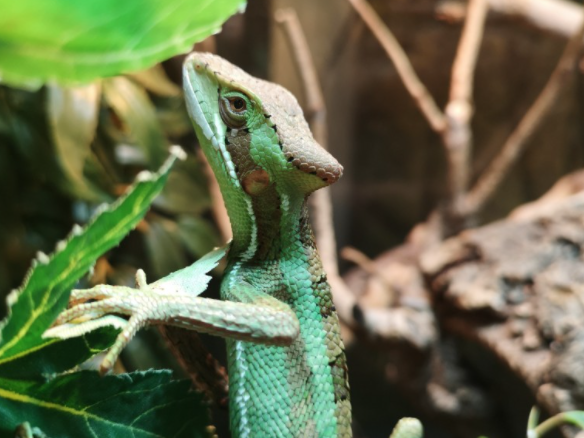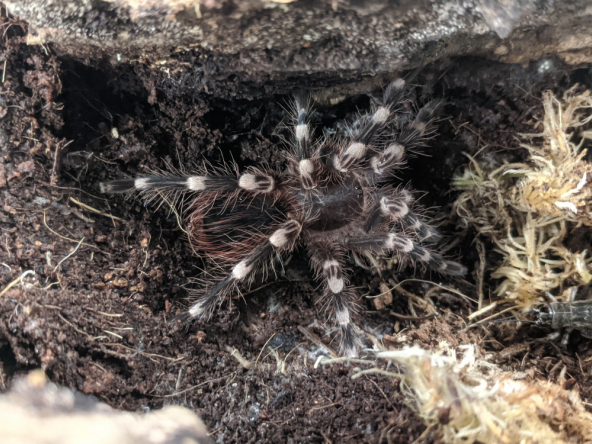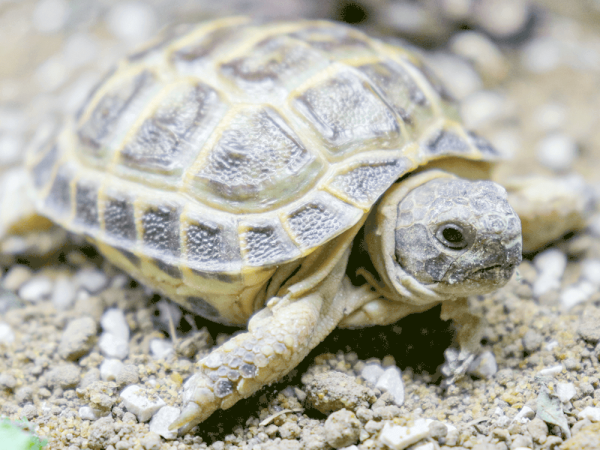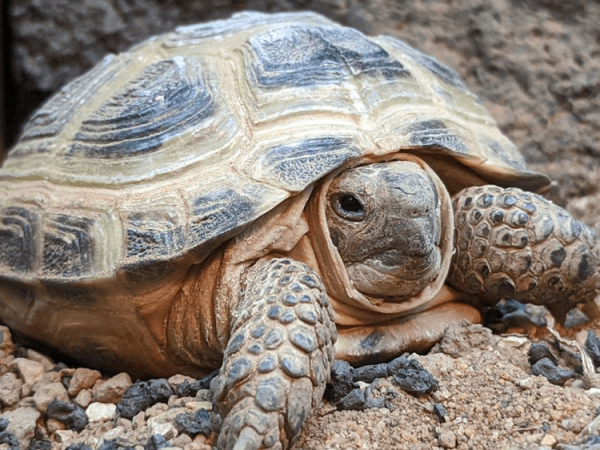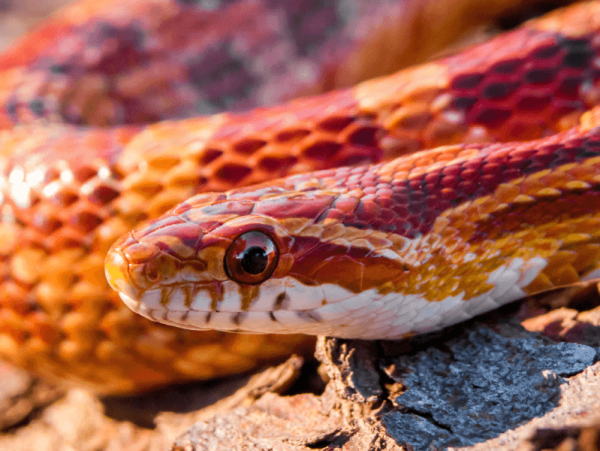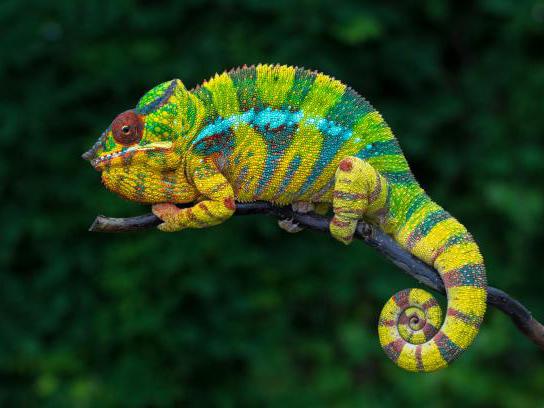Optional extras
Casque head iguana, Laemanctus serratus, care sheet
Categories: Care sheetsLizards
The Casque Head Iguana, also known as the Cone Headed Iguana or Basilisk, is a species found in tropical rain forests in Central America. As the name suggests, they have a crown on the top of the head and are usually bright green in colour, with brown stripes running the length of the body into the tail. They have a very long thin tail that can stretch to almost three times the length of the body. This tail is used in balance to enable them in their extremely agile behaviours. Although quick and nimble, they are tolerant of occasional handling.
Housing
The Casque Head Iguana is a very active lizard that requires a lot of space to move around. A minimum of 90 x 45 x 90cm should be provided to house a single adult, although bigger is definitely appreciated. This will provide good opportunity for horizontal movement as well as all-important arboreal habits.
To begin with, your enclosure will need a good quality loose substrate such as soil which will ensure moisture is held and will also provide the option of a live planted terrarium - much more natural and aesthetically pleasing. It’s also a good idea to think about drainage, consisting of a layer of hydro rocks, matting and then your substrate. This will stop the soil from becoming waterlogged and helps aid humidity in the tank by re-using the water that collects in the bottom layers.
Decor
To be sure that your Iguana can make use of the entire enclosure, a lot of decor will need to be added. It is essential that the climbing structure created is sturdy enough to hold the weight of the animal but also that it creates access to the higher portions of the tank, and make heat and UV more accessible. For this, you could use a variety of branches, logs, vines and foliage.
To allow your Iguana to take cover from heat and UV and hide from view, you should also use some of this decor to create sufficient 'off show' areas - for example, dense foliage over a branch to create a hidden area underneath. Being diurnally active, this won’t affect you viewing your Iguana as they still venture out to bask and feed, and they are usually active animals.
Heating and lighting
Heat and UVB are vital elements of any reptile enclosure. For the Casque Head Iguana, you will first require a good heat source - either a basking bulb or ceramic heat emitter are best. Any heat source should be attached to a thermostat for regulation, and safety of the animal. You should also use an accurate digital thermometer for monitoring. This should be placed at the top of the enclosure, facing down as the Iguana would also bask at height.
A temperature of between 30-32C should be maintained in the basking area, with the cooler areas of the tank remaining around 22-25C, allowing your animal to move away from the heat as well as towards it for basking. During the night, you may not need to heat the enclosure, as temperatures can drop to around 15-20C - this mimicking a natural temperature drop experienced by the animals in a wild setting.
Another essential aspect of the enclosure is a good quality UVB light. This will come in the form of a strip bulb such as Arcadia's T5 6% (the strength will depend on the height of the enclosure). This bulb will enable your animal to metabolise key nutrients and use them effectively in the body, as a result, not having this UV can make them extremely ill and even prove fatal. You should use UVB in a 12 hours cycle, going off as the temperature drops. It is also important to note that all UV has a lifespan to be considered, between 6 - 12 months (this again will depend on the bulb and brand). After the lifespan of the bulb is up, the UV will no longer be being emitted, even if the tube is still glowing.
Humidity
Another consideration of this animals environment is the humidity. For Casque Head Iguanas, this should remain between 70 - 90%, measured with an accurate digital hygrometer. To achieve this humidity, the enclosure will require frequent spraying, a good quality, moisture-holding substrate and possibly the addition of a fogger and/or live plants. Another aspect to note is that the Iguana will drink from the water droplets once the terrarium has been sprayed and it is therefore highly recommended that a fountain or dripper is included to ensure that your animal is constantly hydrated. Another good idea is the use of broadleaf plants on which water can collect for them to drink off.
Diet
Your Casque Head Iguana is an insectivore and so will feed on a good variety of small-sized crickets, locust, calci-worms and mealworms. Variety is key in providing your Iguana with good nutrition as all prey items differ in nutritional value. You will also need to dust the live food with additional calcium, multi-vitamins and D3 in the relevant feeding rota to ensure your Iguana gets from everything needed in its diet. It is also recommended that live food be 'gut loaded' before being fed to the animal to make them an even better quality meal.
Swell SuperStore Casque Head Iguana species profile
- Scientific name - Laemanctus serratus
- Adult Expected Size - 8 - 10 inches excluding tail (snout to vent)
- Habitat - Rain forests of Central America. Arboreal living.
- Required Enclosure Size - minimum of 90 x 45 x 90cm
- UV Lighting - 3 - 4 UVI (6% T5 - dependent on the height of the enclosure)
- Expected Lifespan - 7 - 10 Years
- Temperature Gradient - 25 - 32C
- Humidity Levels - 70 - 90%
- Feeding - Insectivores - Mainly live food such as small crickets, locust and worms
- Handling - could be tamed, handling is possible.
Jeremy Gay is an author, lifelong fishkeeper, and exotic pet specialist. He's a former editor of Practical Fishkeeping Magazine, UK editor at Reefbuilders, a former pet store manager, and has collected wildlife in Sri Lanka and the Amazon. He's been on tv and radio, contributed to Koi Carp and Gardeners World magazines, been a product tester, a judge, and a product developer.




